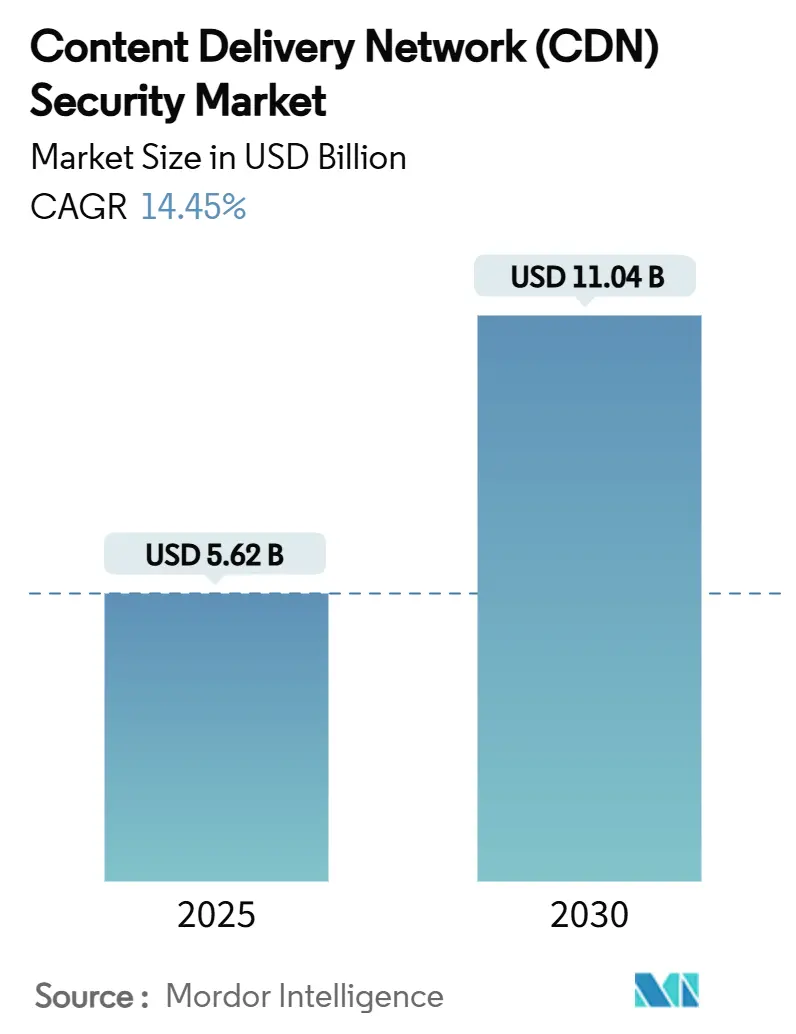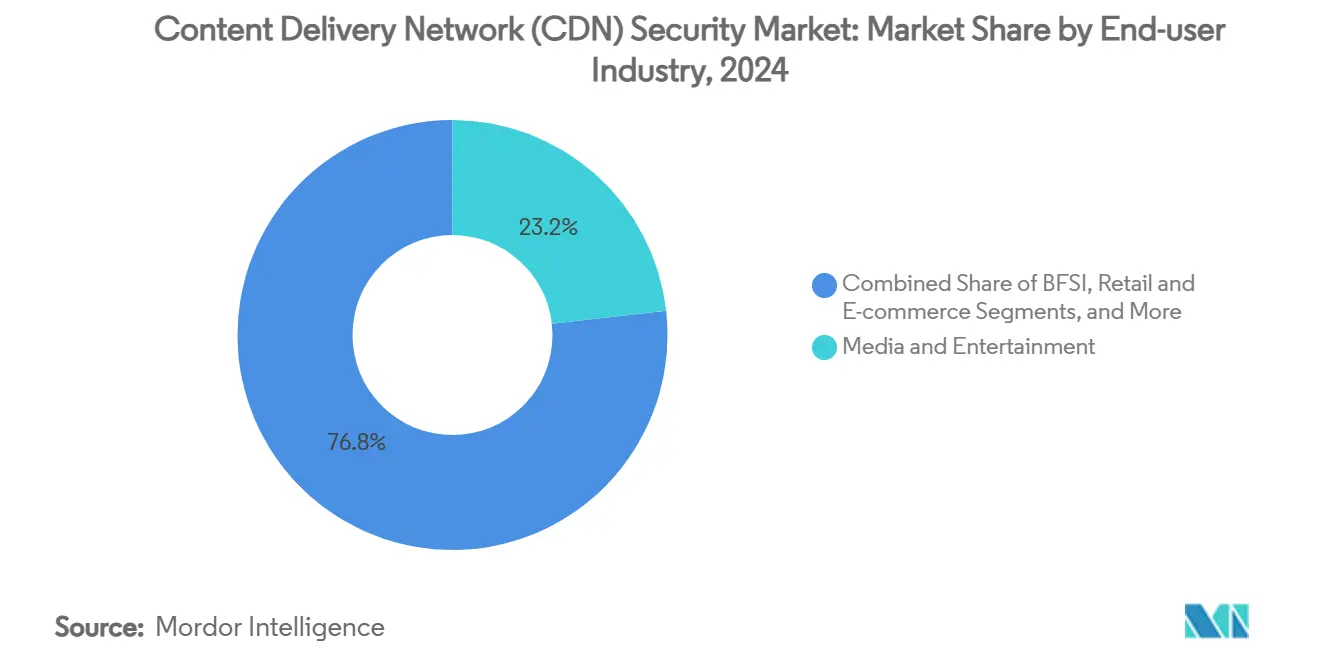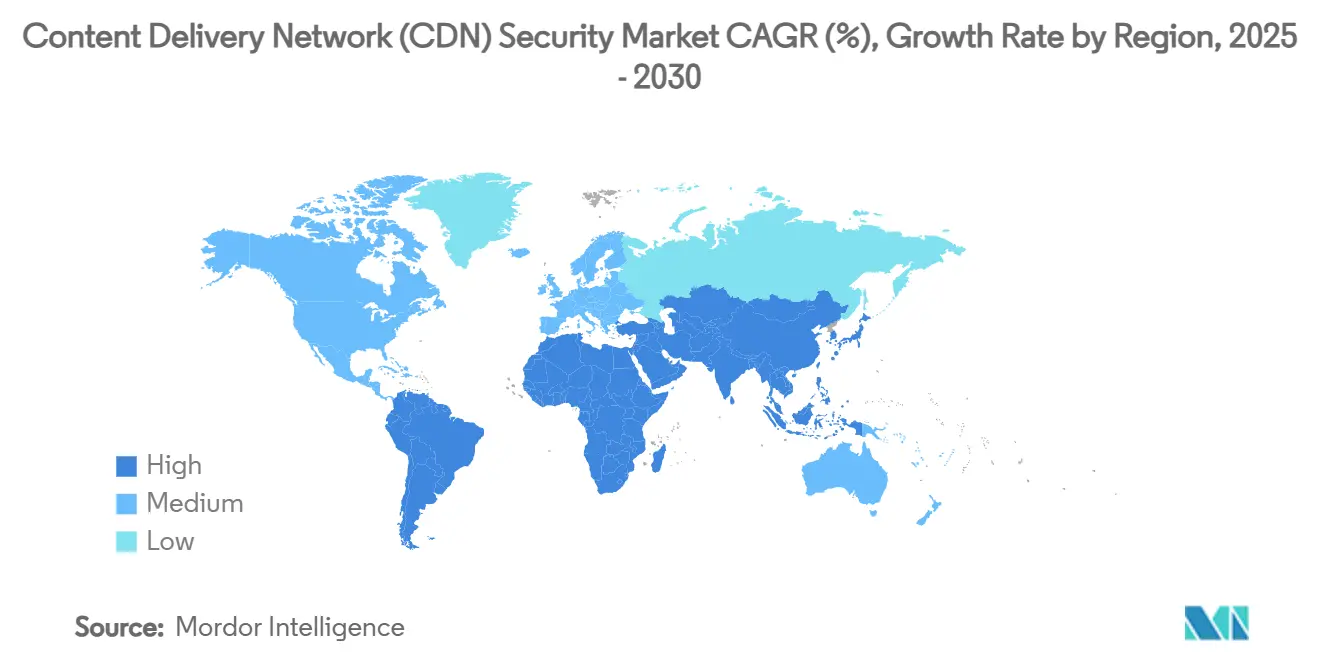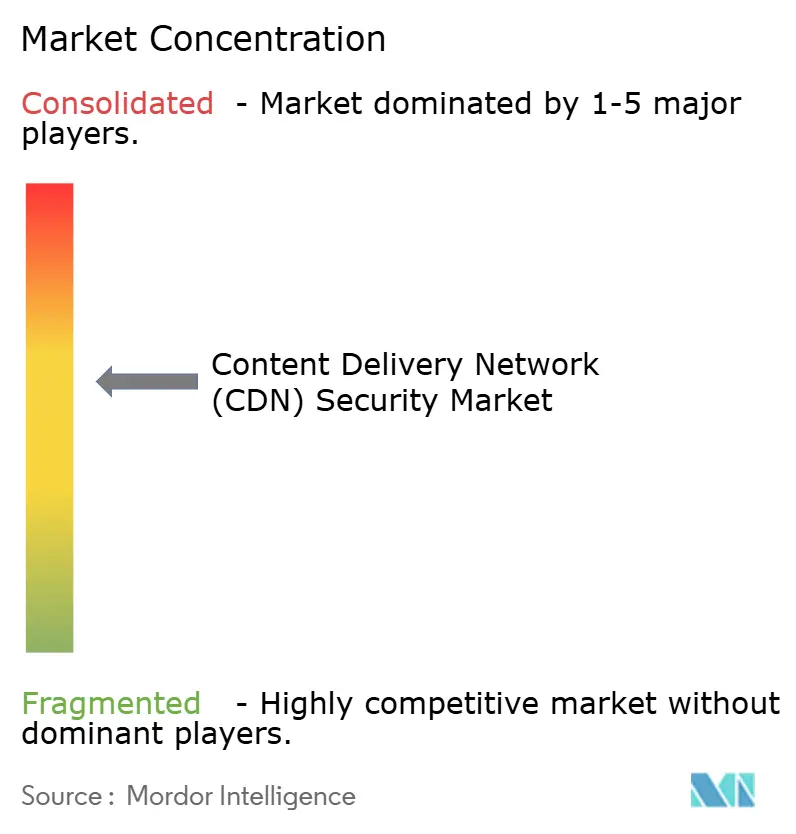Content Delivery Network (CDN) Security Market Size and Share

Content Delivery Network (CDN) Security Market Analysis by Mordor Intelligence
The CDN Security market generated USD 5.62 billion in 2025 and is on track to reach USD 11.04 billion by 2030, advancing at a 14.45% CAGR. Escalating attack volumes, aggressive regulatory deadlines, and the migration of workloads to multi-cloud and edge environments are the primary forces behind this expansion. Enterprises now insist on always-on, behavioral-based mitigation after Cloudflare documented a 358% jump in global DDoS events during Q1 2025, equal to 20.5 million blocked attacks. Mandates such as the EU’s Digital Operational Resilience Act (DORA) and PCI DSS v4.0 elevate compliance risk, while OTT traffic growth pushes content owners to embed security deeper into delivery pipelines. A parallel shift toward cloud delivery enables rapid deployment, illustrated by the 65.7% share that cloud implementations already hold. Competitive intensity is rising as incumbents consolidate (Akamai’s USD 450 million acquisition of Noname) while specialists such as Cloudflare expand AI-powered detection to counter evolving bots and scrapers.
Key Report Takeaways
- By organization size, large enterprises held 75.4% of CDN Security market share in 2024; small and medium businesses are projected to post the fastest 14.7% CAGR through 2030.
- By security type, Web Application Firewalls led with 47.2% revenue share in 2024, whereas bot mitigation is forecast to expand at a 15.3% CAGR to 2030.
- By deployment mode, the cloud segment accounted for 65.7% of the CDN Security market size in 2024 and is growing at a 16.2% CAGR between 2025-2030.
- By end-user, media and entertainment commanded 23.2% share of the CDN Security market size in 2024, while healthcare is advancing at a 14.5% CAGR through 2030.
- By geography, North America led with 32.9% market share in 2024; Asia-Pacific is the fastest-growing region at 15.1% CAGR.
Global Content Delivery Network (CDN) Security Market Trends and Insights
Drivers Impact Analysis
| Driver | (~) % Impact on CAGR Forecast | Geographic Relevance | Impact Timeline |
|---|---|---|---|
| Rising frequency and sophistication of DDoS / L-7 attacks | +3.2% | Global, with highest impact in Asia-Pacific and North America | Short term (≤ 2 years) |
| Rapid growth in OTT video and real-time streaming traffic | +2.8% | Global, concentrated in North America and Europe | Medium term (2-4 years) |
| Enterprise shift to multi-cloud and edge architectures | +2.5% | North America and EU leading, Asia-Pacific following | Medium term (2-4 years) |
| Regulatory uptime and data-protection mandates (e.g., DORA, PCI DSS v4) | +2.1% | EU for DORA, Global for PCI DSS v4 | Long term (≥ 4 years) |
| Edge PoP consolidation enabling embedded zero-trust controls | +1.9% | Global, with early adoption in developed markets | Long term (≥ 4 years) |
| Algorithmic network-cost steering driving security-integrated CDNs | +1.0% | Global, primarily affecting large enterprises | Medium term (2-4 years) |
| Source: Mordor Intelligence | |||
Rising Frequency and Sophistication of DDoS / L-7 Attacks
Cloudflare’s telemetry shows network-layer assaults ballooned 509% year-over-year in Q1 2025, while terabit-scale floods are now routine. Multi-vector campaigns combine SYN floods with Mirai botnets, and reflection methods such as CLDAP and ESP have spiked 3,488% and 2,301% respectively.[1]Field Effect Team, “2025 Global Threat Landscape,” Field Effect, fieldeffect.comCarpet-bombing tactics, 82.78% of all observed attacks in 2024, force organizations to adopt always-on defenses instead of traffic-divert approaches. Financial services remain the primary target as geopolitical tensions spur hacktivism; Akamai logged a 154% rise in sector-focused events in 2023. CDN security vendors now embed ML-driven anomaly scoring at edge PoPs to distinguish legitimate microbursts from malicious floods.
Rapid Growth in OTT Video and Real-Time Streaming Traffic
Subscriber churn correlates directly with stream buffering, prompting platforms to deploy multi-CDN setups plus DRM watermarking. ContentArmor and Limelight upgraded forensic watermarking to curb piracy, integrating directly into delivery layers.[2]Content Armor Staff, “Limelight & ContentArmor Partner for OTT Watermarking,” Content Armor, contentarmor.net Edge-native infrastructure from Qwilt reduces first-frame latency, but its proximity to viewers exposes surface area to credential-stuffing and token theft. Security stacks therefore integrate per-session entropy checks and token binding without inflating latency budgets crucial for live sports.
Enterprise Shift to Multi-Cloud and Edge Architectures
Hybrid workloads erode the traditional perimeter. Akamai highlights that internal API calls now represent 53% of east-west traffic, making visibility essential across VPC hops. The State of Oklahoma consolidated more than 100 agencies through Zscaler Zero Trust, blocking 34,000 encrypted threats and 17.6 million policy violations. Unified policy engines spanning cloud, on-prem and edge PoPs drive demand for platform-agnostic CDN Security market solutions that enforce identity-aware routing and micro-segmentation.
Regulatory Uptime and Data-Protection Mandates
DORA compels EU financial entities to perform resilience testing and third-party risk management or risk heavy fines. PCI DSS v4.0 extends script-monitoring to all website components; requirements 6.4.3 and 11.6.1 formalize tamper detection—a catalyst for advanced WAF rollouts. Shawbrook Bank adopted F5 BIG-IP and Silverline to keep controls uniform across data centers and public cloud, underscoring compliance-driven spending F5. Platforms such as Dynatrace’s newly acquired Runecast automate evidence collection for auditors, shrinking manual compliance overhead.
Restraints Impact Analysis
| Restraint | (~) % Impact on CAGR Forecast | Geographic Relevance | Impact Timeline |
|---|---|---|---|
| Global shortage of skilled cyber-security practitioners | -2.3% | Global, most acute in developing markets | Long term (≥ 4 years) |
| High TCO of always-on mitigation for SMEs | -1.8% | Global, particularly affecting emerging markets | Medium term (2-4 years) |
| IPv6 traffic exposing gaps in legacy filtering appliances | -1.2% | Global, with higher impact in regions with rapid IPv6 adoption | Short term (≤ 2 years) |
| Rising energy costs at edge PoPs slowing footprint expansion | -0.9% | Global, with highest impact in regions with expensive energy | Medium term (2-4 years) |
| Source: Mordor Intelligence | |||
Global Shortage of Skilled Cyber-Security Practitioners
Forty-six percent of reported breaches hit firms with under 1,000 staff, and 82% of ransomware incidents target the same cohort. Universities average up to 1,580 public-facing domains yet often lack security teams to harden them. Providers now ship point-and-click configuration presets and AI triage, but a persistent talent gap slows CDN Security market adoption among resource-constrained buyers.
High TCO of Always-On Mitigation for SMEs
While algorithmic scrubbing can cut bandwidth bills, SMEs still balk at premium features like behavioral analysis. The OECD notes 72% of small firms embrace basic cyber hygiene but struggle with price and know-how barriers.[3]OECD Analysts, “SME Digitalisation Barriers,” OECD, oecd.org Subscription-based “security-as-a-service” offerings from Cloudflare and Radware spread costs monthly, yet currency fluctuation in emerging economies keeps ROI challenging, tempering overall CDN Security market growth.
Segment Analysis
By Organization Size: Large Budgets Dominate, SMEs Accelerate
Large enterprises controlled 75.4% of 2024 revenue thanks to complex infrastructures and deep security budgets that span DDoS, WAF, bot and zero-trust layers. NEC rolled out Zscaler for 120,000 global employees to centralize internet and private-app access. Conversely, SMEs show the strongest 14.7% CAGR as managed cloud models democratize tools once reserved for Fortune 500. Cloudflare’s partnership with Rakuten Mobile offers packaged zero-trust services aimed at Japan’s small-business segment. Talent shortages and cost sensitivities persist, yet simplified dashboards and usage-based pricing unlock adoption.

By Security Type: WAF Reigns, Bot Mitigation Surges
Web Application Firewalls held 47.2% share in 2024, bolstered by PCI DSS v4.0 script-monitoring mandates. Fortinet’s FortiAppSec Cloud combines WAF with performance analytics to streamline deployment. Bot mitigation, expanding 15.3% CAGR, addresses AI-driven scraping and credential abuse. Cloudflare’s AI Labyrinth generates decoy pages to trap illegal crawlers, while HUMAN Security claims 99.9% detection accuracy via intelligent fingerprinting. As attackers weaponize machine learning, layered defenses that join WAF, bot and API protection will shape the CDN Security market trajectory.
By End-User Industry: Media Leads, Healthcare Gains Speed
Media and entertainment contributed 23.2% of 2024 spend as OTT platforms battled piracy and high-capacity floods. Multi-CDN plus DRM watermarking remain standard, with Limelight’s joint work with ContentArmor improving traceability of exfiltrated streams. Healthcare is the fastest riser at 14.5% CAGR; Yale New Haven Health’s March 2025 breach of 5.5 million records renewed urgency for layered defenses. Retail also faces silent bot threats—Chain Store Age cites only 5% of luxury brands as fully protected—fuelling demand for adaptive screening.

Note: Segment shares of all individual segments available upon report purchase
By Deployment Mode: Cloud Supremacy
Cloud implementations account for 65.7% of CDN Security market share, outpacing on-prem with a 16.2% growth rate. TeN’s migration to Cloudflare cut delivery costs while enabling “security-by-default” with always-on DDoS and WAF. SB Technology launched Cloudflare WAF services to counter Japan’s 53% jump in DDoS activity. Hybrid remains a bridge for regulated sectors; F5’s Distributed Cloud lets FNZ extend unified policy to wealth-management apps.
Geography Analysis
North America generated 32.9% of global revenue in 2024. Mature compliance regimes and high per-capita cyber spend underpin adoption. Oklahoma’s statewide Zscaler roll-out blocked 34,000 encrypted threats and 17.6 million policy violations, proving zero-trust viability at scale.
Asia-Pacific is expanding at a 15.1% CAGR. Akamai logged 51 billion web-app attacks against APAC sites in 2024, a 73% jump, with Australia, India and Singapore worst hit. Rakuten Mobile’s partnership with Cloudflare commercializes managed zero-trust for local SMEs, while Japan’s cyber insurance market is growing nearly 50% a year.
Europe sees steady growth as DORA and GDPR tighten operational and data-protection requirements. Banks retrofit API and WAF controls for resilience testing, and Estonia’s Information System Authority relies on Cloudflare to safeguard sovereign digital services. Latin America and Africa remain nascent; CDNetworks now operates PoPs in 20 LATAM countries to reach 600 million subscribers, laying groundwork for future CDN Security market uptake.

Competitive Landscape
Market concentration is moderate. Akamai, Cloudflare and AWS combine scale, global footprints and security portfolios to hold nearly half of global revenue. Akamai’s USD 450 million Noname buy broadened its API shield, followed by asset purchases from Edgio and a USD 100 million cloud contract with a major tech firm. Cloudflare counters with patented CSRF protection and bot-defense IP. Fastly integrates AI-driven bot management, while hyperscalers bundle content delivery and security under unified SLAs. Niche innovators such as Kasada and Corero target specific pain points from infinite challenge loops to high-precision DDoS filters, keeping competitive pressure high. Patent arsenals, vertical specialization and edge network scale now define differentiation across the CDN Security market.
Content Delivery Network (CDN) Security Industry Leaders
-
Akamai Technologies, Inc.
-
Amazon Web Services, Inc.
-
Cloudflare Inc.
-
Imperva Inc.
-
Nexusguard Limited
- *Disclaimer: Major Players sorted in no particular order

Recent Industry Developments
- June 2025: Cloudflare blocked an average 385 million daily cyber events in Japan and widened its Rakuten Mobile zero-trust partnership.
- April 2025: SB Technology debuted Cloudflare WAF services in Japan after a 53% rise in DDoS incidents.
- April 2025: AT&T and Palo Alto Networks integrated connectivity and AI-powered defenses into a joint SASE suite.
- February 2025: Akamai secured a USD 100 million multi-year cloud deal with a global technology company.
Global Content Delivery Network (CDN) Security Market Report Scope
CDN security protects against people who seek to interfere with the website's users. Users may improve the entire experience of viewing their website by enabling safer, more secure information delivery across the network.
The scope of the study for the content delivery network (CDN) security market has considered CDN security solutions for both small & medium scale and large-scale enterprises of different types and their respective applications for a wide range of end-user industries.
The Content Delivery Network (CDN) Security Market is segmented by Organization Size (Small and Medium-scale Business, Large-scale Business), Type (DDoS Protection, Web Application Firewall, Bot Mitigation & Screen Scraping Protection, Data Security, DNS Protection), End-user Industry (Media & Entertainment, Retail, BFSI, IT and Telecom, Healthcare), and Geography(North America, Europe, Asia-Pacific, Latin America, Middle East & Africa).
The market sizes and forecasts are provided in terms of value in USD million for all the above segments.
| Small and Medium-Sized Businesses (SMBs) |
| Large Enterprises |
| DDoS Protection |
| Web Application Firewall (WAF) |
| Bot Mitigation and Screen-Scraping Protection |
| Data Security and Content Integrity |
| Others |
| Media and Entertainment |
| Retail and E-commerce |
| BFSI |
| IT and Telecom |
| Healthcare and Life Sciences |
| Government and Public Sector |
| Education |
| Others |
| Cloud |
| On-Premise |
| North America | United States | |
| Canada | ||
| Mexico | ||
| South America | Brazil | |
| Argentina | ||
| Rest of South America | ||
| Europe | Germany | |
| United Kingdom | ||
| France | ||
| Italy | ||
| Spain | ||
| Rest of Europe | ||
| Asia-Pacific | China | |
| Japan | ||
| India | ||
| South Korea | ||
| Southeast Asia | ||
| Rest of Asia-Pacific | ||
| Middle East and Africa | Middle East | Saudi Arabia |
| United Arab Emirates | ||
| Turkey | ||
| Rest of Middle East | ||
| Africa | South Africa | |
| Nigeria | ||
| Egypt | ||
| Rest of Africa | ||
| By Organization Size | Small and Medium-Sized Businesses (SMBs) | ||
| Large Enterprises | |||
| By Security Type | DDoS Protection | ||
| Web Application Firewall (WAF) | |||
| Bot Mitigation and Screen-Scraping Protection | |||
| Data Security and Content Integrity | |||
| Others | |||
| By End-user Industry | Media and Entertainment | ||
| Retail and E-commerce | |||
| BFSI | |||
| IT and Telecom | |||
| Healthcare and Life Sciences | |||
| Government and Public Sector | |||
| Education | |||
| Others | |||
| By Deployment Mode | Cloud | ||
| On-Premise | |||
| By Geography | North America | United States | |
| Canada | |||
| Mexico | |||
| South America | Brazil | ||
| Argentina | |||
| Rest of South America | |||
| Europe | Germany | ||
| United Kingdom | |||
| France | |||
| Italy | |||
| Spain | |||
| Rest of Europe | |||
| Asia-Pacific | China | ||
| Japan | |||
| India | |||
| South Korea | |||
| Southeast Asia | |||
| Rest of Asia-Pacific | |||
| Middle East and Africa | Middle East | Saudi Arabia | |
| United Arab Emirates | |||
| Turkey | |||
| Rest of Middle East | |||
| Africa | South Africa | ||
| Nigeria | |||
| Egypt | |||
| Rest of Africa | |||
Key Questions Answered in the Report
What is driving the rapid growth of the CDN Security market?
Surging DDoS and bot attacks, tougher regulations such as DORA and PCI DSS v4.0, and enterprises’ migration to multi-cloud and edge architectures collectively push the market toward a 14.45% CAGR through 2030.
Which segment of the CDN Security market is expanding the fastest?
Bot mitigation is projected to grow at 15.3% CAGR as AI-powered scraping and credential abuse outpace traditional defenses.
Why are small and medium enterprises adopting CDN security services?
SMEs face the same threat landscape as large firms but lack in-house expertise; cloud-delivered, subscription-based security solutions lower upfront spending and simplify management, supporting a 14.7% CAGR for the segment.
How does the regulatory environment influence CDN security spending?
Rules like DORA and PCI DSS v4.0 require continuous monitoring, script-level defenses and detailed reporting, compelling financial services and e-commerce firms to invest in advanced WAF, DDoS and compliance dashboards.
Which regions present the greatest growth opportunity?
Asia-Pacific shows the highest 15.1% CAGR, fueled by digital transformation, rising cyber insurance uptake and significant attack volumes reported across Australia, India and Singapore.
Page last updated on:
_Security_Market_Major_Players_Logo.webp)


